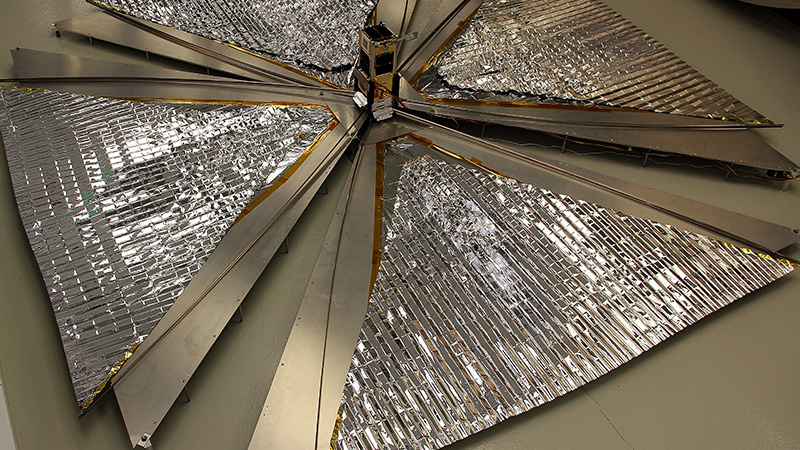Drag sails could counter debris
By Debra Werner|September 2017
Developers of kilogram-class satellites who want to be good stewards of low Earth orbit now have some flight data to assess about drag sails as a possible means of deorbiting without the need for propellants once their missions are done.
As of Aug. 10, the four drag sail segments that sprang from the CanX-7 satellite in May had reduced the spacecraft’s altitude by 5 kilometers, said Bradley Cotten, the CanX-7 project manager at the University of Toronto’s Space Flight Laboratory.
Cotten, a researcher at the lab, gave a presentation at the annual Utah State University Small Satellite Conference.
As particles high in the atmosphere strike each sail segment, the force slows the 3.6-kilogram satellite slightly and forces it to sink lower. The technology could be an option for deorbiting spacecraft such as nanosatellites, defined as those weighing 1 to 10 kilograms.
Each sail segment has an area of about a square meter and is made of a flexible and lightweight aluminized polyimide. The sails remained folded and stowed away inside modules during CanX-7’s secondary mission, which was to demonstrate the ability of a nanosatellite to collect aircraft identity and location broadcasts.
After collecting about 4.6 million of these automatic dependent surveillance-broadcast messages over seven months, the lab sent a command to activate a heating element that melted a cord, made of the polymer fiber Vectran, that held each door closed. Strips of copper beryllium alloy wound into tape springs pushed the doors open, unfurling the segments of the drag sail around the cubesat as they unwound.
The effect on CanX-7’s altitude could be seen immediately, Cotten said.
Researchers at the Toronto lab and elsewhere want to give nanosatellite builders the ability to comply with a 15-year-old rule created by the multinational Inter-Agency Space Debris Coordination Committee. The rule calls for satellite operators to deorbit their spacecraft within 25 years of the completion of their missions. Nanosatellite developers fear that if their industry does not follow the rule, governments will impose new regulations.
“This is a bolt-on solution that can go on pretty much any spacecraft in the future to allow it to meet that deorbit guideline,” Cotten said.
He expects CanX-7 to burn up in the atmosphere long before the 25-year mark. That could happen in less than three years if the drag sail moves into a position perpendicular to the cubesat’s orbit as expected to maximize drag. In the worst-case scenario, it could take 4.5 years. Without the drag sails, CanX-7 would succumb to atmospheric drag in about 178 years, Cotten said.
Editor’s note: In the photo at the top of this page, four drag sail segments attached to the CanX-7 satellite, shown in development, may provide a new way to remove satellites from orbit. The photo was provided by the University of Toronto Institute for Aerospace Studies
Space Flight Laboratory.








